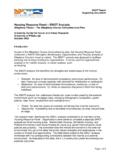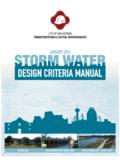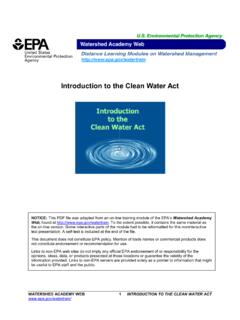Transcription of Act 167 Stormwater Management Planning SupportingDocs
1 PA Act 167 Watershed Stormwater Management Planning DEFINITION. Stormwater Management has been traditionally defined as measures used by property owners and local governments to limit the amount of Stormwater runoff from urban development and to control the path of runoff through space and time. More recently, the concept of Stormwater Management is being expanded to include water quality considerations. The content of this paper is limited to Stormwater quantity Management . SIGNIFICANCE OF Stormwater Management CONCERNS. General Traditionally, curbs, gutters, and underground pipes have been provided to remove Stormwater from developed property as quickly as possible so as to minimize the possibility of localized flooding. Moreover, in the past little or no efforts were expended to minimize increases in the amounts of runoff generated or the rates at which the increased runoff occurred due to the conversion of land from a permeable, vegetated condition to an impervious, paved condition.
2 As development in a watershed progresses, this approach results in ever increasing Stormwater runoff until damaging downstream problems develop. Problems attributable to increased Stormwater runoff resulting from indiscriminate and uncontrolled development include both flooding and accelerated erosion. Common law rule regarding surface runoff holds that an owner of lowlands must accept the amount ( the volume and velocity) of runoff that naturally drains on his or her land. Similarly, an owner of uplands cannot by artificial means cause (1) an unnatural quantity of runoff; (2) an unusual velocity of runoff; or (3) an unnatural contamination of runoff water to be discharged to another person's property, thereby causing damage. These common law rules apply to the actions of communities and government agencies as well as individual landowners. These rules have historically been applied when excessive runoff or runoff velocity is "unnaturally" cast onto other lands or streams with recognizable harmful results.
3 For instance, courts have awarded damages to: _ a landowner whose parcel was subjected to the discharge of a neighbor's ditch which was being used to drain a swamp;. _ a township whose highway, bridges and culverts were injured by the increase flow from the digging and deepening of drains;. _ lake owner's injured by the contamination and increased runoff from a subdivision drain. The subdivision developer was ordered to undertake a variety of corrective measures; and _ a landowner whose land was eroded by the increased runoff coming from the development of farmland. A city storm sewer flow had to be diverted and the developer was enjoined from increasing runoff. In general, responsibility for preventative approaches to Stormwater Management lies squarely at the local level of government where land use changes are reviewed and regulated. 1 of 8. Consequently, the potential responsibility for downstream damages resulting from approved developments must be recognized by all local government officials.
4 The common law surface water rules indicate that landowners and communities have never had the unrestricted right to alter natural runoff patterns so as to cause damage to the property of others. Fear of damages to downstream communities and resulting law suits has been a strong factor influencing local governments in upstream areas to develop Stormwater Management programs. In Pennsylvania, the responsibilities of levels of government in Stormwater Management are clearly defined. Statutory statements of responsibility make the risks associated with inaction on the local level even more pronounced that those implicit in common law. ACT 167 Stormwater Management . The Pennsylvania General Assembly passed and the Governor signed the "Storm Water Management Act, No. 167 864" on October 4, 1978. The policy and purpose of the Act is to: 1. Encourage Planning and Management of Stormwater runoff in each watershed which is consistent with sound water and land use practices.
5 2. Authorize a comprehensive program of Stormwater Management designated to preserve and restore the flood-carrying capacity of Commonwealth streams, to preserve, to the maximum extent practicable, natural storm water runoff regimes and natural course, current and cross-section of water of the Commonwealth; to protect and conserve ground waters and ground water recharge areas. 3. Encourage local administration and Management of Stormwater consistent with the Commonwealth's duty as trustee of natural resources and the people's constitutional right to the preservation of natural, economic, scenic aesthetic, recreational and historical values of the environment. The general procedure established by the Act for achieving these goals consists of: 1). development of guidelines and regulations to be applied statewide; 2) the preparation of Stormwater Management plans for designated watersheds throughout the state; 3).
6 Implementation of the Stormwater Management plans; and 4) adherence to the plan requirements by land developers. In 1980, the Department of Environmental Resources (DER) designated 353 watersheds that need Stormwater Management plans. Model ordinances were made available to localities in September 1981, followed by detailed Stormwater Management guidelines in June 1983. These guidelines and model ordinances were approved by the Pennsylvania General Assembly in June 1985 and now have the force of law. In May 1984, Act 167 was amended to authorize the Department of Environmental Protection (DEP) to administer grants to municipalities and counties to cover 75% of the costs of preparing and administering Stormwater Management plans and regulations. The Act stipulates that each county must prepare and adopt a watershed Stormwater Management plan for each designated watershed within two (2) years following the promulgation of guidelines by DEP and shall review and revise such plan at least every five (5).
7 Years. The Stormwater Management guidelines were approved on May 14, 1985. Stormwater 2 of 8. Management Plan preparation should, therefore, have been completed by May of 1987. This clearly has not been the case. Plans have been completed for a small percentage of the designated watersheds. Completion of the plans is currently proceeding at a relatively slow pace to the extent that state funding is adequate to permit commitment of the associated 75%. reimbursement. Act 167 stipulates that municipalities must adopt or amend and implement such ordinances and regulations as are necessary to manage Stormwater in a manner consistent with the applicable plan within six (6) months of adoption and approval of the plan. Delineation of Responsibilities Act 167 establishes certain duties and responsibilities for individuals and various governmental agencies as follows: PERSONS ENGAGED IN LAND DEVELOPMENT: Act 167 states that any landowner and any person engaged in the alteration or development of land which may affect Stormwater runoff characteristics must implement such measures consistent with the provisions of the applicable Stormwater Management plan as are reasonably necessary to prevent injury of health, safety or other property.
8 Such measures must include such actions as are required: 1. to assure that the maximum rate of Stormwater runoff is no greater after development than prior to development activities; or 2. to manage the quantity, velocity and direction of resulting Stormwater runoff in a manner which otherwise adequately protects health and property from possible injury. DEPARTMENT OF ENVIRONMENTAL RESOURCES: Act 167 assigns the Department of Environmental Resources the primary responsibility to carry out the policies and purposes of the Act. These responsibilities include providing guidelines for county Stormwater Management plans; designating watersheds for which Stormwater Management plans should be prepared; review and approval of these plans; providing technical assistance and model local ordinances; developing grants and reimbursement regulations governing the disbursement of grant monies; and generally coordinating Stormwater Management activities statewide.
9 COUNTIES: Counties are required to prepare and adopt a watershed Stormwater Management plan for each designated watershed in their jurisdiction. MUNICIPALITIES: Municipalities are required to adopt new or to amend existing regulations as necessary to comply with and implement the Stormwater Management plans. Procedure As the preceding delineation of responsibilities suggests, there is an established procedure which must be followed in order to satisfy the Stormwater Management responsibilities established by Act 167. As indicated above, the counties are responsible for completing and adopting the Stormwater Management plans. In general, the active county agency involved in these efforts is the County Planning Commission or Planning Department. Stormwater Management has also been completed by regional Planning agencies. The following 3 of 8. paragraphs summarize the PA Act 167 Watershed Stormwater Management Plan preparation process.
10 Watershed Designation As was indicated previously, full fledged Stormwater Management is required by Pennsylvania law to be implemented in designated watersheds. The responsibility for the watershed designation was assigned and completed by the Department of Environmental Resources. DEP has designated over 350 watersheds statewide. These designations were completed and approved and published in 1980 in consultation with the counties and following public hearings. Obtain Phase I Planning Grant The Department of Environmental Resources has notified all counties to inform them of the designation of watersheds in their jurisdictions and invite them to respond through the preparation of Stormwater Management plans. At the present time, DEP is not forcing counties to prepare the plans. If a county desires to perform a Stormwater Management plan it must notify DEP. If sufficient funds are available, DEP will fund Phase I of the plan.




